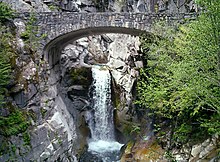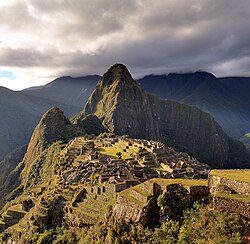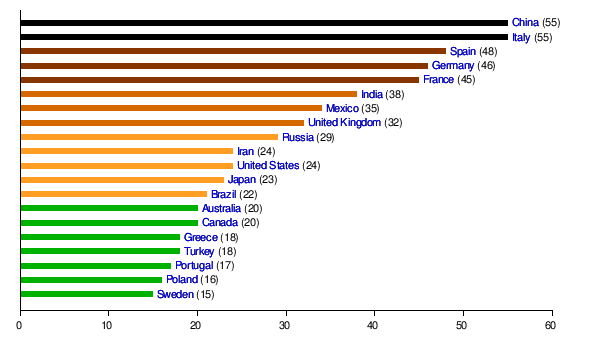| Mount Rainier National Park | |
|---|---|
IUCN category II (national park)
| |

Mount Rainier from above Myrtle Falls
| |
| Location | Pierce County and Lewis County, Washington, United States |
| Nearest city | Tacoma |
| Coordinates | 46°51′N 121°45′WCoordinates: 46°51′N 121°45′W |
| Area | 236,381 acres (956.60 km2) |
| Visitors | 1,518,491 (in 2018) |
| Governing body | National Park Service |
| Website | Official website |
Mount Rainier National Park is an American national park located in southeast Pierce County and northeast Lewis County in Washington state. The park was established on March 2, 1899 as the fifth national park in the United States, preserving 236,381 acres (369.3 sq mi; 956.6 km2) including all of Mount Rainier, a 14,411-foot (4,392 m) stratovolcano. The mountain rises abruptly from the surrounding land with elevations in the park ranging from 1,600 feet to over 14,000 feet (490–4,300 m). The highest point in the Cascade Range, Mount Rainier is surrounded by valleys, waterfalls, subalpine meadows, and 91,000 acres (142.2 sq mi; 368.3 km2) of old-growth forest. More than 25 glaciers descend the flanks of the volcano, which is often shrouded in clouds that dump enormous amounts of rain and snow.
Mount Rainier is circled by the Wonderland Trail and is covered by glaciers and snowfields totaling about 35 square miles (91 km2). Carbon Glacier is the largest glacier by volume in the contiguous United States, while Emmons Glacier is the largest glacier by area. Mount Rainier is a popular peak for mountaineering with some 10,000 attempts per year with approximately 50% making it to the summit.
History
Ohanapecosh Glacier, as seen from the Wonderland Trail
Ninety-seven percent of the park is preserved as wilderness under the National Wilderness Preservation System as Mount Rainier Wilderness, a designation it received in 1988. It is abutted by the Tatoosh, Clearwater, Glacier View, and William O. Douglas Wildernesses. The park was designated a National Historic Landmark on February 18, 1997 as a showcase for the National Park Service Rustic style architecture of the 1920s and 1930s, exemplified by the Paradise Inn and a masterpiece of early NPS master planning. As a Historic Landmark district, the park was administratively listed on the National Register of Historic Places.
Native Americans
The
earliest evidence of human activity in the area which is now Mount
Rainier National Park, a projectile point dated to circa 4,000–5,800 BP (before present) found along Bench Lake Trail (the first section of Snow Lake Trail).
A more substantial archeological find was a rock shelter near
Fryingpan Creek, east of Goat Island Mountain. Hunting artifacts were
found in the shelter. The shelter would not have been used all year
round. Cultural affinities suggest the site was used by Columbia Plateau Tribes from 1000 to 300 BP.
In 1963 the National Park Service contracted Washington State University to study Native American
use of the Mount Rainier area. Richard D. Daugherty lead an
archeological study of the area and concluded that prehistoric humans
used the area most heavily between 8000 and 4500 BP. Allan H. Smith
interviewed elderly Native Americans and studied ethnographic
literature. He found no evidence of permanent habitation in the park
area. The park was used for hunting and gathering and for occasional spirit quests. Smith also came to tentative conclusions that the park was divided among five tribes along watershed boundaries; the Nisqually, Puyallup, Muckleshoot, Yakama, and Taidnapam
(Upper Cowlitz). Subsequent studies cast doubt on Smith's theory that
the tribes had agreed upon boundaries before they entered into treaties
with the United States in 1854–55.
Flora
According to the A. W. Kuchler U.S. Potential natural vegetation types, Mount Rainier National Park has an Alpine Meadows & Barren, or Alpine tundra (52) potential vegetation type with an Alpine Meadow (11) potential vegetation form.
Fauna
Mammals that inhabit this national park are especially the cougar, black bear, raccoon, coyote, bobcat, snowshoe hare, weasel, mole, beaver, red fox, porcupine, skunk, marmot, deer, marten, shrew, pika, elk, and mountain goat. The common birds of this park including raptors are the thrush, chickadee, kinglet, northern goshawk, willow flycatcher, spotted owl, steller's jay, Clark's nutcracker, bald eagle, ptarmigan, harlequin duck, grouse, peregrine falcon, Canada jay, golden eagle, grosbeak and finch.
Park creation
The Mount Rainier
Forest Preserve should be made a national park and guarded while yet its
bloom is on; for if in the making of the West Nature had what we call
parks in mind—places for rest, inspiration, and prayers—this Rainier
region must surely be one of them.
John Muir
At the summit of Mount Rainier, 1888. Left to right: D.W. Bass, P. B. Van Trump, John Muir, N.O. Booth, Edward Sturgis Ingraham.
On March 2, 1899, President William McKinley signed a bill passed by Congress authorizing the creation of Mount Rainier National Park, the nation's fifth national park. It was the first national park created from a national forest. The Pacific Forest Reserve had been created in 1893 and included Mount Rainier. It was enlarged in 1897 and renamed Mount Rainier Forest Reserve. John Muir had visited Mount Rainier in 1888. Muir and nine others, including Edward Sturgis Ingraham, Charles Piper, and P. B. Van Trump, climbed to the summit in what became the fifth recorded ascent.
The trip to Mount Rainier had played a role in reinvigorating
Muir and convincing him to rededicate his life to the preservation of
nature as national parks. At the time national forests, called forest
reserves at first, were being created throughout the American West,
under the utilitarian "conservation-through-use" view of Gifford Pinchot.
Muir came to be known as a "preservationist". He wanted nature
preserved under the more protected status of national parks. But during
the 1890s there was more public support for creating national forests
than national parks. During that decade, Muir and his supporters were
only able to protect one national forest as a national park. When the Pacific Forest Reserve was created in 1893, Muir quickly persuaded the newly formed Sierra Club to support a movement to protect Rainier as a national park. Other groups soon joined, such as the National Geographic Society and scientific associations wanting Mount Rainier preserved as a place to study volcanism and glaciology. Commercial leaders in Tacoma and Seattle were also in support, as was the Northern Pacific Railway.
The effort lasted over five years and involved six different attempts
to push a bill through Congress. Congress eventually agreed, but only
after acquiring assurances that none of the new park was suitable for
farming or mining and that no federal appropriations would be necessary
for its management.
2006 flooding
Mount Rainier National Park closed because of extensive flooding as a result of the 6 November 2006 Pineapple Express
rainstorm when 18 inches (460 mm) of rain fell in a 36-hour period.
Campsites and roads throughout the park were washed away. Power to
Paradise and Longmire was disrupted. Sunshine Point Campground, just
inside the Nisqually Entrance, was destroyed and has not reopened. On 5 May 2007, the park reopened to automobile traffic via State Route 706 at the Nisqually Entrance.
Climate
According to the Köppen climate classification system, the best definition for Mount Rainier National Park is Mediterranean-influenced Subarctic climate
(‘’Dsc’’). ‘’Dsc” climates are defined by their coldest month averaging
below 0 °C (32 °F), 1–3 months averaging above 10 °C (50 °F), at least
three times as much precipitation in the wettest month of winter as in
the driest month of summer. According to the United States Department of Agriculture, the Plant Hardiness zone
at Sunrise Visitor Center (6,398 feet (1,950 m) elevation) is 6a with
an average annual extreme minimum temperature of -5.5 °F (-20.8 °C).
The National Park Service says that "Paradise is the snowiest place on Earth where snowfall is measured regularly." During the winter of 1971/72 1,122 inches (28.5 m) of snow fell, setting a world record for that year. Subsequently, in the winter of 1998/99, Mount Baker Ski Area received 1,140 inches (29 m). Paradise holds the Cascade Range record for most snow on the ground with 367 inches (9.32 m) on 10 March 1956.
| Climate data for Paradise Ranger Station (1981–2010) | |||||||||||||
|---|---|---|---|---|---|---|---|---|---|---|---|---|---|
| Month | Jan | Feb | Mar | Apr | May | Jun | Jul | Aug | Sep | Oct | Nov | Dec | Year |
| Record high °F (°C) | 65 (18) |
62 (17) |
70 (21) |
78 (26) |
88 (31) |
86 (30) |
87 (31) |
94 (34) |
89 (32) |
88 (31) |
78 (26) |
66 (19) |
94 (34) |
| Average high °F (°C) | 34.9 (1.6) |
35.7 (2.1) |
37.9 (3.3) |
42.1 (5.6) |
49.3 (9.6) |
54.7 (12.6) |
63.3 (17.4) |
64.5 (18.1) |
58.1 (14.5) |
47.9 (8.8) |
37.3 (2.9) |
33.8 (1.0) |
46.6 (8.1) |
| Daily mean °F (°C) | 28.7 (−1.8) |
28.9 (−1.7) |
30.8 (−0.7) |
34.0 (1.1) |
40.5 (4.7) |
45.5 (7.5) |
53.0 (11.7) |
54.2 (12.3) |
48.9 (9.4) |
40.1 (4.5) |
31.0 (−0.6) |
27.4 (−2.6) |
38.6 (3.7) |
| Average low °F (°C) | 22.5 (−5.3) |
22.1 (−5.5) |
23.7 (−4.6) |
25.9 (−3.4) |
31.8 (−0.1) |
36.2 (2.3) |
42.7 (5.9) |
43.9 (6.6) |
39.7 (4.3) |
32.3 (0.2) |
24.7 (−4.1) |
21.1 (−6.1) |
30.6 (−0.8) |
| Record low °F (°C) | −13 (−25) |
−18 (−28) |
−2 (−19) |
2 (−17) |
13 (−11) |
13 (−11) |
20 (−7) |
26 (−3) |
18 (−8) |
2 (−17) |
−11 (−24) |
−20 (−29) |
−20 (−29) |
| Average precipitation inches (mm) | 18.24 (463) |
12.69 (322) |
12.56 (319) |
8.30 (211) |
5.89 (150) |
4.11 (104) |
1.95 (50) |
1.97 (50) |
4.71 (120) |
10.43 (265) |
20.28 (515) |
17.17 (436) |
118.3 (3,005) |
| Average snowfall inches (cm) | 118.7 (301) |
91.6 (233) |
90.6 (230) |
67.5 (171) |
26.1 (66) |
5.6 (14) |
0.3 (0.76) |
0.1 (0.25) |
1.4 (3.6) |
24.1 (61) |
120.9 (307) |
124.0 (315) |
670.9 (1,702.61) |
| Average precipitation days (≥ 0.01 in) | 21.1 | 17.8 | 21.5 | 18.8 | 15.4 | 12.8 | 7.3 | 6.6 | 9.6 | 15.0 | 21.7 | 21.1 | 188.7 |
| Average snowy days (≥ 0.1 in) | 18.5 | 15.9 | 19.5 | 14.4 | 7.9 | 2.5 | 0.2 | 0.1 | 0.7 | 6.2 | 16.6 | 19.0 | 121.5 |
| Climate data for Sunrise Visitor Center, Mount Rainier National Park. (Elev: 6309 ft / 1923 m) 1981–2010 | |||||||||||||
|---|---|---|---|---|---|---|---|---|---|---|---|---|---|
| Month | Jan | Feb | Mar | Apr | May | Jun | Jul | Aug | Sep | Oct | Nov | Dec | Year |
| Average high °F (°C) | 30.5 (−0.8) |
32.1 (0.1) |
35.2 (1.8) |
39.8 (4.3) |
46.4 (8.0) |
51.9 (11.1) |
60.8 (16.0) |
61.8 (16.6) |
56.1 (13.4) |
44.7 (7.1) |
33.8 (1.0) |
29.6 (−1.3) |
43.6 (6.4) |
| Daily mean °F (°C) | 24.9 (−3.9) |
25.3 (−3.7) |
27.5 (−2.5) |
31.4 (−0.3) |
37.6 (3.1) |
43.0 (6.1) |
50.7 (10.4) |
51.6 (10.9) |
46.9 (8.3) |
37.3 (2.9) |
28.2 (−2.1) |
24.1 (−4.4) |
35.8 (2.1) |
| Average low °F (°C) | 19.4 (−7.0) |
18.5 (−7.5) |
19.9 (−6.7) |
23.0 (−5.0) |
28.8 (−1.8) |
34.1 (1.2) |
40.6 (4.8) |
41.3 (5.2) |
37.7 (3.2) |
29.8 (−1.2) |
22.6 (−5.2) |
18.6 (−7.4) |
27.9 (−2.3) |
| Average precipitation inches (mm) | 11.84 (301) |
8.73 (222) |
8.12 (206) |
5.52 (140) |
3.80 (97) |
4.08 (104) |
1.83 (46) |
1.22 (31) |
2.93 (74) |
5.29 (134) |
12.38 (314) |
13.19 (335) |
78.93 (2,005) |
| Average relative humidity (%) | 80.0 | 74.7 | 69.4 | 72.6 | 68.6 | 68.1 | 69.0 | 66.7 | 65.7 | 68.0 | 79.6 | 80.3 | 71.9 |
| Average dew point °F (°C) | 19.6 (−6.9) |
18.4 (−7.6) |
18.8 (−7.3) |
23.6 (−4.7) |
28.2 (−2.1) |
33.2 (0.7) |
40.9 (4.9) |
40.9 (4.9) |
36.0 (2.2) |
27.7 (−2.4) |
22.7 (−5.2) |
18.9 (−7.3) |
27.5 (−2.5) |
Major Attractions
Mount Rainier National Park panorama
The entire park was designated a National Historic Landmark District on February 18, 1997, in recognition of the consistently high standard of design and preservation the park's National Park Service Rustic-style architecture. The park contains 42 locations designated on the National Register of Historic Places, including four National Historic Landmarks.
Paradise
View of the south face of Mount Rainier from the Skyline Trail in Paradise
Paradise (46.79°N 121.74°W[25])
is the name of an area at approximately 5,400 feet (1,600 m) on the
south slope of Mount Rainier in the national park. Paradise is the most
popular destination for visitors to Mount Rainier National Park. 62% of the over 1.3 million people who visited the park in 2000 went to Paradise. Paradise, near the subalpine valley of the Paradise River, is the location of the historic Paradise Inn (built 1916), Paradise Guide House (built 1920) and Henry M. Jackson Visitor Center (built 1966;
demolished and replaced, 2008).
Longmire
National Park Service 1928 Administration Building at Longmire
Longmire (46.75°N 121.81°W) is a visitor center in Mount Rainier National Park, located 6.5 miles (10.5 km) east of the Nisqually Entrance. The area is named after James Longmire, an early settler in Puget Sound. The area is in the Nisqually River valley at an elevation of 2,761 feet (842 m) between The Ramparts Ridge and the Tatoosh Range. Longmire is surrounded by old-growth Douglas fir, western red cedar and western hemlock.
Longmire is the location of Mount Rainier's National Park Inn,
the Longmire Museum, and the 1928 National Park Service Administration
Building, which is now a Wilderness Information Center. The National
Park Inn is the only accommodation in the park open all year round.
Longmire is the second most popular destination for visitors to
Mount Rainier National Park after Paradise. Of the more than 1.3 million
people who visited the park in 2000, 38% visited Longmire. The Cougar Rock Campground is about 2 miles (3.2 km) north west of Longmire
with 173 individual campsites and 5 group sites and open from late May
through late September. Longmire is one of the starting points of the Wonderland Trail.
Sunrise
The Emmons Glacier (upper left) dominates the northeast face of Mount Rainier in the view from the subalpine meadows of Sunrise (lower right).
Sunrise (46.91°N 121.64°W) is a lodge and visitor center
located in the northeastern part of the park. At an elevation of 6,400
feet (1,950 m), it is the highest point in the park that is accessible
by vehicle. There are miles of trails located all around Sunrise, such as Mount Fremont, Burroughs Mountain, and Sourdough Ridge. The lodge is reachable via a 10-mile (16 km) turnoff from SR 410 near the White River entrance.
Other developed areas
Christine Falls, one of many waterfalls visible after a short walk from the main road
Ohanapecosh /oʊˈhænəpɪkɔːʃ/
is a campground (with 188 individual sites and 2 group sites, open from
late May through late September), visitor center (closed during the
2013 season), and ranger station located in the southeastern portion of the park, approximately 3 miles (4.8 km) from the park boundary off Highway 123.
Located in a deep valley among old growth forest at an elevation below
2,000 feet (610 m), it is the only developed area of the park without a
view of Mount Rainier. The Ohanapecosh Hot Springs, Grove of the
Patriarchs, and Silver Falls are all located in the Ohanapecosh area.
The Carbon River Entrance Station is located in the northwest corner of the park off Highway 165 and is the site of the only rainforest
at Mount Rainier. There is a campground and a short trail through the
rainforest, as well as a trail to the Carbon Glacier, one of the lowest
glaciers in the contiguous United States.
Mowich Lake is the largest and deepest lake in the park,
located south of Carbon at the south end of Highway 165. A campground,
picnic area, and hiking trail are located near the lake.
The two major roads into the northwest quadrant of the Park were
severely damaged by the floods of 2006. The ranger station at the Carbon
River entrance is staffed during the summer. No motor vehicles are
permitted beyond that point.

















